Nicola Griffith's Blog, page 37
July 7, 2021
Things disabled people do
The title is, of course, disingenuous: I have absolutely zero idea of what ‘disabled people’ do because we are myriad, more than a quarter of the population. I would not presume to speak for billions. What I will do is speak for myself and talk about what I, a disabled person, do.
Why do I want to do that, why flaunt my disability? Because July is Disability Pride Month. And while lots of people yell and scream and preen and beam for Gay Pride—I did too, back in the day (my first Pride March was London, 1979)—Crip Pride isn’t yet a massive, corporate-sponsored institution.
The thing about Pride, though, is that it’s complicated. Just as without heteronormativity there can be no queerness, and—if you subscribe to the social model of disability, as I do—without ableist culture no disability, without shame there would be no pride.
Shame is baked into Otherness; many of us struggle with it at some point, no matter how fleetingly. The lucky ones among us get past it. So, yes, pride as a notion can be problematic. But as one tiny step towards dismantling the shame monolith that looms over so many of us, I thought I’d talk a bit about life as a crip—and along the way perhaps make disability seem a bit less exotic and/or scary for you nondisabled folks. Kidding! I’m not doing it for nondisabled people at all. I’m doing it for me and mine: I’m going to trumpet and celebrate all the good, fine and fun things I do despite the world actively conspiring to shove me and those like me out of sight.
First of all, I drink beer! In public, for all to see! A lot of beer. Probably more than is strictly necessary. Because I really like it. (Yes! Crips enjoy doing things that aren’t the extra special best things for their health.) I go to pubs and enjoy pints of Guinness with friends. (Yes! Crips have friends!)
 Aaaah. That hits the spot! We’re here; we drink beer. Get used to it.
Aaaah. That hits the spot! We’re here; we drink beer. Get used to it.  Me, Colleen—a friend we’ve known for more than 20 years—and Kelley at our neighbourhood pub: the first time we’ve all been together since lockdown
Me, Colleen—a friend we’ve known for more than 20 years—and Kelley at our neighbourhood pub: the first time we’ve all been together since lockdownImage descriptions: Top—a big old pint of Guinness on a pub table by a window that looks out onto a sunlit neighbourhood street. Bottom—Three white women at a pub table. The one on the left (Nicola) has short fair hair and sits in a wheelchair and holding an almost empty pint of Guinness. The one in the middle is standing with her arms around the shoulders of the other two. The one on the right is sitting. The table is littered with empty glasses. They are all grinning.
I also go out to restaurants, and enjoy lunches and dinners and cocktails with friends—different friends, because crips have many friends! Because, yes, some crips like good food and fabulous wine; some crips can afford to eat in fine-dining establishments and drink in hip cocktail bars. (Though sadly some crips always forget to take pictures of these things, sigh.)
And those pubs and restaurants and bars aren’t just in the US, because, hey, some crips travel, too, flying across the Atlantic First Class when times are good.
So how does this crip afford to flaunt her disabled self in First Class and among the Great and Good in tony hotel bars? She earns money! How does she earn money? By writing fabulous, multiple award-winning, optioned-by-the movies, zillion-times translated novels!
 Me signing books after winning my second Washington State Book Award in 2019 for SO LUCKY—a novel about becoming a crip
Me signing books after winning my second Washington State Book Award in 2019 for SO LUCKY—a novel about becoming a cripImage description: A short-haired white woman (Nicola) in grey suit jacket and black turtleneck and pants sits in a wheelchair with a book open on her lap and a pen poised to write something while looking at someone off-camera and waiting.
I also perform. In public. For entertainment (mine as much as yours) and profit (almost wholly mine—certainly not yours).
 Me doing a live, staged radio show interview
Me doing a live, staged radio show interview Me in a downtown studio narrating SO LUCKY audiobook
Me in a downtown studio narrating SO LUCKY audiobookImage descriptions: Top—Nicola in a wheelchair on a stage, speaking out to the audience, some of whom are visible at lower right. Bottom—Nicola in headphones, sitting on a stool with her wheelchair in the background, in front of a complicated microphone set-up and reading stand, sipping camomile tea from a white mug.
How do I get to these events? In my very own wheelchair-adapted Honda Odyssey GT—with an 11-speaker sound system, full navigation package, and luscious leather seats—with hand controls. Because this crip at least refuses to be reliant upon the kindness of strangers or be pushed around like a sack of potatoes; I’m lucky enough to be able to move under my own power, and in style.
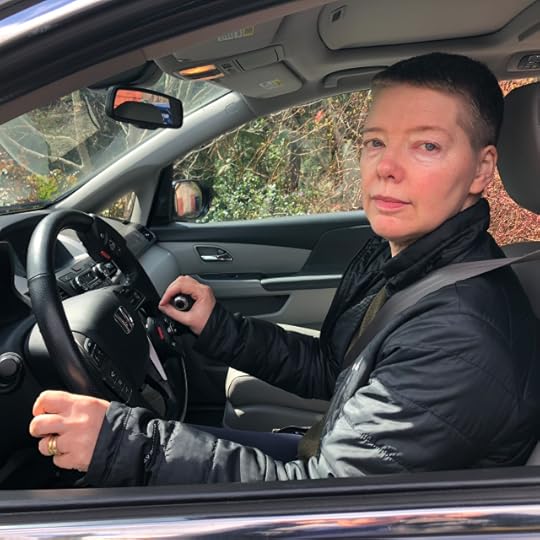 At the controls of my super-adapted vehicle
At the controls of my super-adapted vehicleImage description: Nicola sitting at the wheel of her adapted vehicle with right hand on an electronic steering knob and left hand on a push-rock brake/accelerator.
And how do I do that? In a piece of cutting-edge technology: a supercool all black ultralight, motion-assisted manual wheelchair. It’s such a sleek and enviable piece of tech that the most discerning creatures on earth—cats—try to claim it for their own.
 Charlie loves my wheelchair
Charlie loves my wheelchairImage description: a tabby cat curled up fast asleep on a sleek, all-black wheelchair standing in front of a sunlit orange wall.
I also draw a bit, and play the ukulele occasionally—though not in my wheelchair. I drink wine in the evenings with my sweetie, sitting in the sunshine among the flowers on the deck of our lovely house. Yes! Crips deserve and often have love! Crips deserve to enjoy sunshine and flowers—they even choose the flowers and buy the flowers and plant the flowers! They deserve to and sometimes do live in lovely houses!
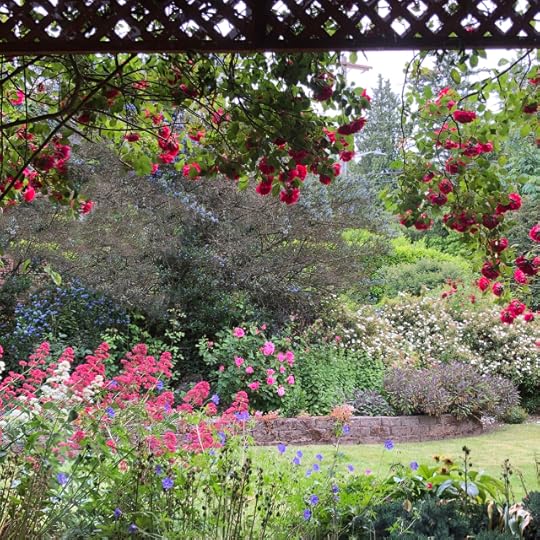 The view from our front window in late May
The view from our front window in late May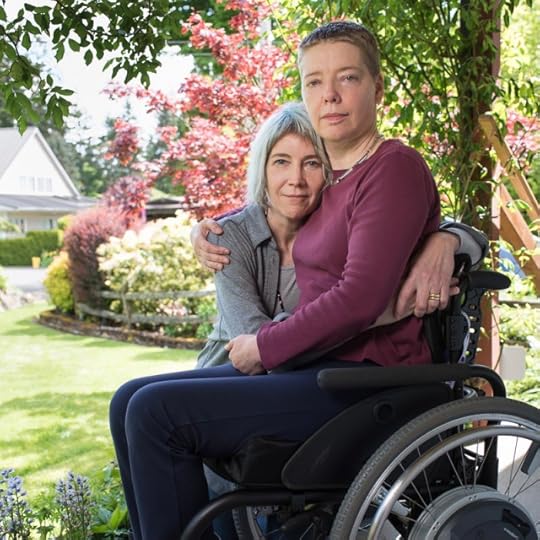 Kelley and I sitting just outside the same window in early April. Photo by Anita Corbin for Invisible Girls Revisited.
Kelley and I sitting just outside the same window in early April. Photo by Anita Corbin for Invisible Girls Revisited.Image descriptions: Top—a photo of garden taken through a living room window. The window is framed by hanging red roses and the rest of the garden is a riot of colour: green, blue, purple, red, pink and white. You can almost smell the fragrance.
And you know what else I do? I fight. Crips are nobody’s pawns, objects of pity, or icons of inspiration. Sometimes we have tempers, don’t give a shit, are unwashed, slothful, and happy so to be. Sometimes we are shameless.
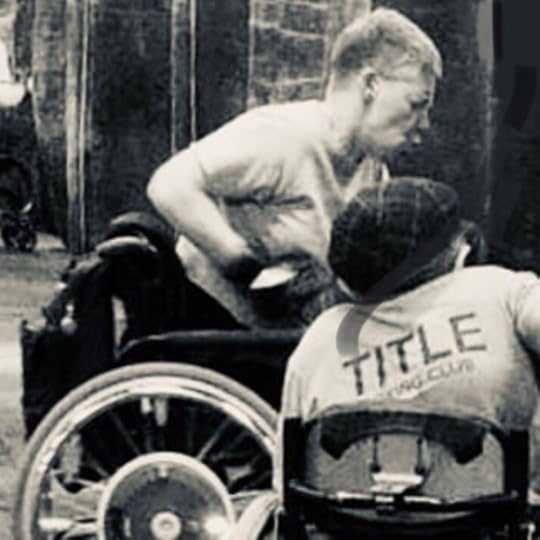 I do like to hit things
I do like to hit thingsImage description: Black and white blurred photo of Nicola in a wheelchair at the boxing gym, wearing MMA gloves and pounding the shit out of a heavy bag, while her instructor—also in a wheelchair—looks on.
If you want to know more about any of the disability stuff I’ve mentioned, go read some of the other posts, essays, and speeches on the subject:
Coming out as a cripple—including an explanation of the social model of disabilityLame is so gay—a rant about ableist and homophobic languageMy new wheelchair van—what it is and how it works, in great detailSO LUCKY wins the Washington State Book Award—why I was surprisedRecording the SO LUCKY audiobook—long, detailed post about my first audio narrationTravelling with a wheelchair and Flying internationally with a wheelchair—the nitty-gritty of wheelchair travelGirls of Lost Subcultures—the early 80s photo exhibit featuring me and my ex that was briefly sensational again three years agoNeither Dying Nor Being Cured—a transcript of the Ethel Louise Armstrong lecture I gave at Ohio State UniversityDisability: Art, Scholarship, and Activism—a presentation on the role of literature in cultural change#CripLit Archives—where you can read the archived Twitter chats about various aspects of disability literature, plus find links to lists of book-length fiction that passes the Fries TestAnd if you want others’ perspectives, go follow #DisabilityPrideMonth hashtags on Twitter and Instagram and if you’re feeling generous donate some money. I don’t need it (not anymore) but a lot of people do—and Disability Pride has no huge corporate sponsors, disabled people don’t earn huge speaking fees, and disabled artists—writers, musicians, dancers—do not get fat grants.
July 3, 2021
Çaturday with Charlie and George
 Charlie looking his fuzzy self
Charlie looking his fuzzy selfImage description: Black and white digital drawing of a mackerel tabby cat sitting upright facing the viewer with his tail stretched to the right. He sits slightly skewed, his whiskers are luxuriant, and his fur is fine and full.
A drawing of Charlie using Procreate (mostly). I’m still experimenting—mixing and matches brushes, trying (with limited success) to find the right textures. It’s harder with Charlie than with George because his fur is stippled rather than striped; it’s also finer and longer. It makes it harder to capture definite outlines.
George is simpler to draw; he was also my first Procreate guineapig:
 George thinks he’s still a kitten
George thinks he’s still a kittenImage description: Black and white digital drawing of a tabby cat too big for his old kitty condo and so having to half sit, half stand on two platforms at once.
Even though George was my first Procreate kitty portrait, in some ways I think it’s more successful than Charlie’s. This beginner’s luck is something I’ve noticed often over the years, whether with physical activity or artistic practise: the first unselfconscious aikido move/sketch/song/story/axe-throw/clay model/painting is always far better than it has any right to be, and then it takes weeks to reach the point where I can consciously create something as good as that first unselfconscious attempt—which often wasn’t that great to start with. So of course what happens is that most of those hobbies turn out to not be worth the bother.
Some hobbies do turn into part- or full-time professions, at least for a time: singing and music; martial arts and women’s self-defence; writing. But there’s a limit to how many for-money occupations a person can have—especially ones that don’t pay brilliantly. Some go back to being hobbies—but only if it’s with unfamiliar instrument/tools. So for example I no longer teach self-defence of practise karate or aikido, but I like wheelchair boxing. I no longer sing with a band, but I like to noodle around with my ukulele. But these no-longer-professions are only fun for me if the results are very, very clearly amateurish and I don’t take it seriously. Because the minute I take it seriously I get obsessive. Obviously I didn’t give up on writing, and now that I’ve found the right non-messy tools—my iPad and Pencil—I suspect I won’t give up on drawing. The trick is to do it for play not pay—which is part of the reason I’m sharing this stuff publicly even though it’s not very good: it’s so that I don’t obsess about trying to make it good enough for pay; to not worry about it being (very much) less than perfect. Time will tell. But right now I’m having a good time.
The lovely thing about drawing the cats is that I’m spending a lot of time observing them closely which is always a joy. I’m learning to see them more clearly. For example, both Charlie and George tend to sit slightly off-kilter in the same way—though mirror images, with their tails going in opposite directions. Their eyes are differently positioned, too. And Charlie’s pupils are almost always less dilated than George’s.
Anyway, in the future expect occasional kitty pix of varying quality.
June 27, 2021
Historic, dangerous, prolonged, and unprecedented
The title is a direct quote from the Weather Service about the heat dome over the Pacific Northwest. Meterologist are falling back on deeply scientific language, calling it Meteorologists are describing the situation as “insane,” “bonkers” and “incredible.” According to the Washington Post:
The strength of the heat dome . . . is simply off the charts. Its intensity is so statistically rare that it might be expected only once every several thousand years on average.
Washington Post
Once every several thousand years? Yeah, no. I think this is just a shot across our bows; just the beginning.I chose Seattle 25 years ago because of its temperate climate—specifically, because one late September night in Atlanta I woke up at 2 in the morning and it was still 74 degrees. No, I thought. No no no. Won’t. And we moved. Yet last night, at 2:38 am outside it was 86 degrees. This is so far from ‘normal’ I can’t wrap my head around it.
Here in Seattle:
yesterday hit 102today heading for 106tomorrow to hit 111For those who use 21st century measures, 111ºF is 44ºC. This heat is so all-encompassing that frankly I’m finding it hard to wrap my head around it. Yet we’re lucky: we live in one of Seattle’s real cool spots:
 Image description: heat map of Seattle just north and south of the ship canal. Colours range from red (hottest) to blue (coolest). On small island of blue to the north is marked with a purple dot and purple arrow.
Image description: heat map of Seattle just north and south of the ship canal. Colours range from red (hottest) to blue (coolest). On small island of blue to the north is marked with a purple dot and purple arrow.Also, we have central air-conditioning. This is good—I think I might be dead without it (I have MS: my nerve signals fail when I overheat)—but our system just isn’t designed to handle temperatures 21 degrees above previous records.
We’ve offered help to friends, and shelter for neighbours. I hope everyone out there has cold water, shade, and pre-cooked food. See you on the other side.
June 26, 2021
Indivisible—except by 3 and 11
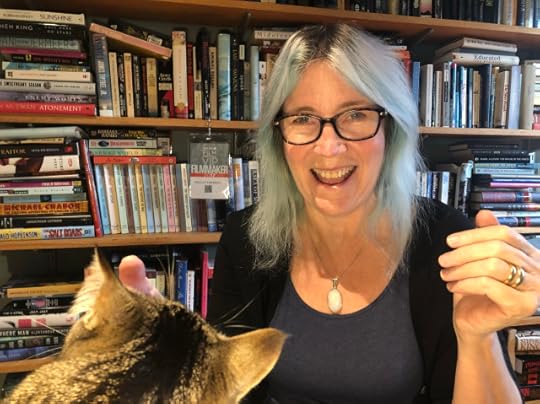 I took this photo of Kelley in her home office in November, 2020. George helped.
I took this photo of Kelley in her home office in November, 2020. George helped.Image description: Colour photo of a woman and tabby cat sitting in front of a wall of books. She has long hair, bleached to silver, tinted with turquoise, and is wearing glasses and a simple, single stone opal pendant that matches her hair. She is looking at the camera, laughing, gesturing with her hands—she wears two wedding rings on the ring finger of her left hand—and seems delighted with the world and the cat, who is licking her right hand.
33 years ago today I met Kelley. It was a wicked hot day—just as today (and tomorrow, and Monday) will be—and we were young, 27. I’ve told this story many times before and so won’t rehash it here; feel free to go look at 30 years: a love story in photos, or read an excerpt from my memoir about the moment we met.
I know that my 27 year-old self was real (and in fact at the time Kelley and I met I considered myself a mature adult with vast life experience) but I sometimes have a hard time believing I ever had a life without Kelley in it.
She’s an amazing woman. I love her. I’ve loved her since the moment we met (though of course she didn’t believe me for a while). We’ve married twice: the first time in 1993, long before it was legal, the second time on the 20th anniversary of our first wedding, when we could legally call each other Wife. I’ll love her til the day I die, which frankly I hope is not for at least another 33 years.
Please have a most marvellous weekend—we certainly plan to—and raise a glass to love, of all and every kind.
June 20, 2021
Kitten Report #18: Two-and-a-bit years old
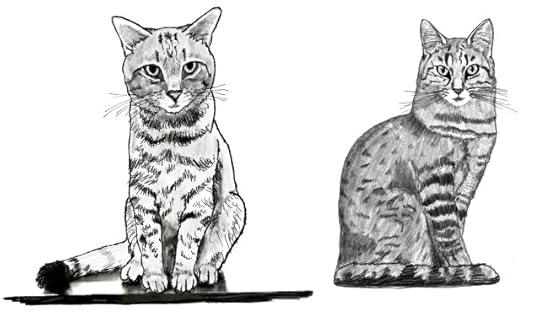 Made on the occasion of their second birthday as an experiment in digital drawing
Made on the occasion of their second birthday as an experiment in digital drawingImage description: Black and white digital sketch of two tabby cats. The one on the right is made to look like a pencil sketch; he sits neatly, tail around his toes, in profile except for is head which is turned to stare directly at the viewer as if to say, “What, exactly, are you begging to do for me?” The one on the left looks like a black and white gel pen and brush image of a cat on a table. He is sitting slightly crooked and leaning forward a little, with his tail not quite curled around his toes, and his eyes wide and quizzical.
These are the sketches I made of Charlie and George on their second birthday.[1] That was five weeks ago; they are no longer kittens but full-grown cats. At least I think so. Kelley swears that George is still growing. (We’ll find out at the end of summer when we take them in for their annual inspection and tune up.) Charlie, however, is definitely no longer growing. George weighs about 50% more than Charlie—though you wouldn’t think so from the sketches. When you don’t see them side by side there are times you’d automatically assume Charlie was bigger: he has this ability to look weighty and luxuriantly furred—whereas in reality he’s very sightly built; his bones are slender; his neck is about half the width of George’s. He also has the ability to just stretch and stretch and stretch until he looks like a mile of leopard-spotted belly
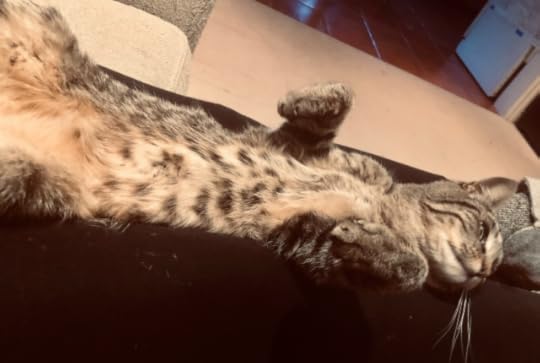 Charlie has the longest belly in the world
Charlie has the longest belly in the worldGeorge, even now, can look very young and uncertain.
 I’m just not sure…
I’m just not sure…They’re both healthy. Although they both—Charlie particularly—occasionally suffer a flare of their kitty herpes (sore throat, sore gums, a slight bubble in the breath) it never lasts longer than a couple of days and it doesn’t affect their appetite for food, lap time, and play.
In terms of appetite, dear god they eat a lot! Charlie still won’t touch anything but canned kitten food—he ignores cat treats; ignores fresh (and cooked) chicken or fish; doesn’t even care to chase chickpeas or steal broccoli (something our other cats did). But if you put down a can of Fancy Feast Tender Chicken Feast (Kitten) he can hoover up the whole thing in about sixteen seconds (yes, I’ve timed him). He’s marginally less fond of Tender Turkey (that takes him more like 22 seconds).
 Charlie demolishes one plate of food, nears the end of the second, and considers of the third—though because it’s human food (fish) he ends up not touching it
Charlie demolishes one plate of food, nears the end of the second, and considers of the third—though because it’s human food (fish) he ends up not touching itGeorge eats a lot of Tender Chicken, not much Tender Turkey, but manages his body weight in shrews, voles, moles, and mice. He’d add birds to that if he could (he brought home his second bird last week—more on that below). He also adores Orijen natural freeze-dried cat treats, but only the original flavour. He will also occasionally graciously accept cooked beef, cod, and chicken (though is not keen on pork or lamb or bacon).
So they’re grown cats, but in many ways they the same as those tiny kittens we brought home in August 2019. Charlie is the extrovert of the family, and his moods are alarmingly mercurial with the highs and lows turned up to 11: sweet and loving, wholly demonic, plaintive, Cardinal-in-all-his-Medici-glory, territorial, playful, and limp—when he’s still, he’s utterly inert; otherwise, he doesn’t stop moving. George is more introverted and cerebral: by turns cautiously playful, mildly mournful, wild-eyed-and-feral, pondering, or desperate for love—which involves many yowls, head bumps, scritches, treats (rinse and repeat), then kneading, then suddenly jumping up and going away. The picture I drew of him (above) is his quintessential doubtful self—wanting to be loved, but not entirely sure it’s a good idea. He thinks a lot; he’s one of the most thinking cats I’ve ever known. He;s both wary and smart.
Charlie is smart, too, but less thinky—and he has much less stubbornness and stamina than his brother; he’ll attack a problem headlong—and very often figure it out—but he has to figure it out fast; after two attempts he’s done; he’s bored; he walks off. He can’t understand why, if he wants something, it doesn’t just, y’know, happen. After all, he’s a god; or at least the Pope. Self-doubt is not his thing.
Charlie still goes first: still tries everything first; still first to wake us up and demand breakfast; first out of the door in the morning. He’s much more pushy and demanding: he knows with every fibre of his being that he’s adorable and loved.
George, well, I’m not sure George even now always quite believes he’s safe—most all the time, yes, but any sudden noise (especially men, or women with loud voices and heavy treads) and he vanishes. But when he thinks he’s safe he’s the sweetest cat on earth.
 Alternately watching Time Team and guarding my head
Alternately watching Time Team and guarding my headCharlie will jump at a loud noise—but then immediately go investigate it. He’s not 100% fearless—but he’s not far off. Last week I looked out of the window and saw a raccoon in the front flowerbed—with Charlie sitting about two feet away. I nearly had a heart attack. Fortunately it was a young raccoon and a bit nonplussed by a morsel-sized cat just sitting there. Kelley shot outside and ran it off; Charlie came in looking nonchalant—but with his tail fluffed like a bottle brush.
Their relationship to each each has changed, though it’s hard to describe. They’re both more and less at ease with each other. It used to be that as kittens they always hung out together. Outside as young cats it was a different matter: they’d immediately peel off in different directions. Now I often see them sharking about together. Yesterday they tried a pincer move on a squirrel. The squirrel was on the back fence, and Charlie left onto the fence behind it, George in front of it. They started mincing (it’s less than half an inch thick) towards the squirrel, which immediately made a death-defying leap into a tree with branches too thin to support a cat—which didn’t stop Charlie leaping after it, and falling off, while George, startled, also fell off, leaving the squirrel shrieking at them both from the tree and two crows laughing raucously at the lot of them.
Indoors, though, during the day they are only in the same room if one or both of us is there; even so, they prefer separate perches.
 Charlie with me, George by the fire, Kelley in the chair off screen—on the last day of the fire before autumn
Charlie with me, George by the fire, Kelley in the chair off screen—on the last day of the fire before autumnOn the rare occasions they’re inside during the working day (usually when it’s raining), Charlie likes to sleep in front of my screen, or next to Kelley’s keyboard.
 After deleting all my copyedits for SPEAR, again (it’s a gift) Charlie sleeps the sleep of the righteous
After deleting all my copyedits for SPEAR, again (it’s a gift) Charlie sleeps the sleep of the righteousLike Kelley, Charlie sleeps like the dead. George is more like me—part of him is never switched off. In the afternoon he will sleep next to me on the sofa (when I’m reading/researching, or just watching science or history TV—he seems to like that) in his green-blanket-and-yellow-cushions fort, but if I’m working and he really wants uninterrupted sleep he creeps under the bed where he’s built himself another fort by the floor vent so no one can surprise him.
These days, the only time they spend tumbled together is at bedtime, on the bed, with us. It can take a while to get to this deceptively peaceful state, though.
 Yeah, no, I don’t trust him, either
Yeah, no, I don’t trust him, eitherGeorge, particularly, likes my attention at bedtime. He gets grumpy when I try to read. In fact he took such a dislike to this particular book that after six months I still haven’t made it past page 20.
Do. Not. Read. Pay. Attention.They fight a lot, usually when George wants Charlie to give him some love and Charlie just wants to sleep. George will sidle up and offer to clean Charlie’s head—which Charlie is fine with; it’s when George moves to the throat that things go sideways. George can’t seem to grasp that he shouldn’t choke his brother out like a prey animal, while Charlie, quite reasonably, objects to having his oxygen and blood supply cut off. They have a knock down drag out fight right there, then thunder around the place for half an hour. As this invariably begins on the bed at two in the morning, I—quite reasonably—also object. Kelley doesn’t care because Kelley could sleep through both a zombie attack and the nuclear explosion that created the viral mutation that led to the zombies in the first place.
Charlie is much better at the give-bruv-some-luv thing: he can clean George for hours, and frequently does. Occasionally he’ll meditatively sort of suck on George’s ear, which every so often turns into trying to bite it off, but this is rare, and they rarely have a big fight as a result—probably because George is not the least threatened by his brother, who is only two-thirds George’s size.
But if they had their way they would spend hardly any time indoors. We try to keep it to roughly nine-to-five outside and the rest of the time in the house. This does not always work. In summer, particularly, they are now trying to persuade us to let them out earlier and earlier. They don’t understand the crepuscular hunting habits of coyotes, raccoons, and owls; all they know is is the sun is shining and they want out!
Charlie tries yowling—well, given his damaged vocal cords it’s more a chirruping squeak—but George’s preferred mode is fixed staring.
 You are feeling the urge to open the door…
You are feeling the urge to open the door…Charlie has taken to copying him, though he hasn’t quite got the hang of it yet: he thinks staring at the table is the way to go.
 It’s not working…
It’s not working…Every now and again he tries to sneak out disguised as recycling.
 Ha, ha, George. This is how you do it!
Ha, ha, George. This is how you do it!Charlie is much, much better about coming home when called, though. With George we can never rely on his timing; the other day he didn’t come home until 4 in the morning. Those days are rare, but I hate them: he comes home black-eyed, wild, and skittish. I know how he would be as a feral cat.
They continue to kill many small beasts. Their routine: Charlie generally catches the mole/vole/shrew/mouse, brings it home, kills it (except those times he gets bored and drops it and wanders off—in which case George dispatches it efficiently), and George gives the dead beast a couple of perfunctory flings, then eats every single scrap, starting with the head (I no longer flinch at the crunching sound). Occasionally he’ll leave the liver—always (sigh) on the white carpet.
George brought home their second bird—the first he’d killed. (Charlie brought home the first, a pine siskin; George ate it and nearly died of salmonellosis.) Although this one wasn’t a pine siskin and so less likely to be infected we still had it from him in a split second—but sadly not before he covered the entire (white) carpet in feathers (sigh).
I’ve really noticed the seasonal change in their coats; outside they glow like sunlit sandstone—particularly George. Sometimes he looks like some unknown alloy of gold and ginger. This filtered photo captures something of the colour he turns in full sun. It can be pretty startling.
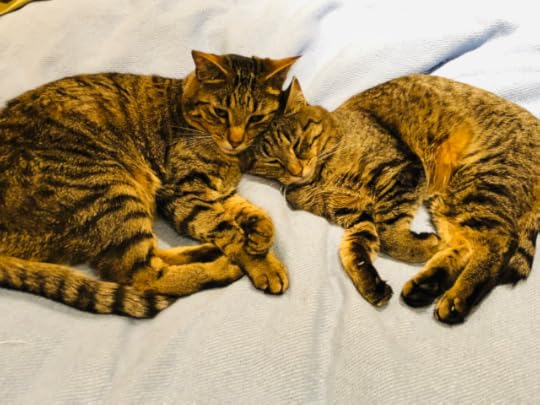 Charlie, wake up! Wake up! Your brain is ticking…
Charlie, wake up! Wake up! Your brain is ticking…George still will not be picked up, though allows himself to be held if he climbs on a lap voluntarily; Charlie is fine with it. Despite their foibles or more likely because of them, we love them fiercely and look forward to another twenty years with our furry aliens.
 These are not the droids you’re looking for…
These are not the droids you’re looking for…I might draw an occasional picture, and maybe do an update at the end of summer after they’ve been to the vets for their booster jabs and a general exam. Meanwhile, please feel free to amuse yourselves with previous Kitten Reports.
[1] Well, okay, George was drawn on his birthday; Charlie wouldn’t pose for me until about a week later. And even then every time I tried to draw him my app crashed and ate the work-in-progress. So his pic is a bit more stiff than George’s.
June 8, 2021
Me and Laurie Frankel in conversation: Friday 11th June, 4pm Pacific, on Zoom
Laurie is a Seattle writer and friend. We have—well, okay, had—lunch regularly to talk about our work, books, life, the universe and everything. Since the pandemic we’ve had a few Zoom happy hours—but this will be our first event together. I’m looking forward to it.
Laurie is smart, warm, and generous in person—and all that as a writer, too, along with a particular gift for characters who feel simultaneously real, specific, and unexpected. (If you haven’t yet read This Is How It Always Is, about the family of a trans child, you should.) Her latest novel is One, Two, Three, a tale of ecology and environment, capitalism and greed, disability and adversity and triumph. But it’s good triumph: real and earned triumph. There are no miracle cures, no suicides, no pity and no inspiration porn. There’s a lot of delight in this novel, yes, but, again, it is always earned.
Laurie does something very interesting in this book, something that very few people have been able to figure out: she norms the Other in terms of disability. Here’s the blurb I gave the book:
One Two Three is a powerful and nuanced novel about hope, human frailty, and love. Laurie Frankel takes a clear-eyed look at the mess we make of the world when we privilege profits over people and, brilliantly, without flinching from the truth, allows no hint of contempt, disgust, or hatred to enter the conversation. Three sisters, Mab, Monday, and Mirabel, understand that you can’t fight old problems with traditional tools. Their gifts and differences and love for each other help them to understand that their mother―and by extension our mothers—can’t make the change the world needs. It’s up to the daughters to act, to move us forward, to tell a different story. It is the daughters who will save us. One Two Three is the blueprint for a true revolution.
We’ll talk about the book a lot, of course, because always the point of these things, but along the way we’ll cover writing process in general, highs and lows in particular, norming the Other, why girl superheroes are nothing like boy superheroes—and how that relates to my notion of Real Heroes (my terms for the dreaded ‘heroine’), and almost anything else you might want to know. There’ll be at least 15 mins Q&A: just type your question in the chat box as we talk and get an answer from either or both of us. It’s like magic. And did I say it’s free? And you can join from anywhere i the world?
See you on Friday. Bring your questions!
June 5, 2021
Hild’s bynames #3: Little Prickle
 My drawing from an Adobe Stock photo 63039127. Except that link is no longer working. So I don’t know the photographer’s name, but over on iStock the credit is to eve-eve01genesis.
My drawing from an Adobe Stock photo 63039127. Except that link is no longer working. So I don’t know the photographer’s name, but over on iStock the credit is to eve-eve01genesis. Image description: Black and white drawing of a hedgehog with its face lifted, snuffing the air after truffling about in the forest litter at its feet. The parts of the forest litter that are identifiable are elm leaves and twigs, oak leaves, and two acorns.
Normally I do these byname post over on Gemæcce, my research blog, but as this particular name is more of a pet name than an earned adult name, I thought I’d do it here. Why? I’m not sure—perhaps because Little Prickle is a personal name—given by her mother and Onnen, the women who raise her—and so doesn’t belong with the more awe-inspiring definitely-not-fond fear-power-and-violence related bynames she acquires as she gets older.
European hedgehogs—or hedgepigs as Hild would say—Erinaceus europaeus, are native to Britain but the Romans introduced a domesticated variety, perhaps the African four-toed (or white-bellied) hedgehog Atelerix albiventris, or perhaps a cross between that and another breed.[1] They were kept as pets—they eat anything, insects, worms, fruit, nuts—but also as meat, and their skins with their long sharp spines were useful for combing and cleaning woollen garments, and individual spines could be used as pins.
I assume hedgehogs developed their spines for self-defence: they’re eaten by badgers, owls, and other predators. I’m guessing a hungry fox might tackle one if it was desperate enough to risk a face full of spines.
So why Little Prickle? Let me quote from near the beginning of Hild:
Onnen pushed Hild forward. The visitors, both slight, with magnificent moustaches and the air of brothers, turned.
“Ah,” said the taller one in British. Strange British, from the west. “You have your father’s hair.”
Yffing chestnut, her mother called it. And her outside one big prickliness like a chestnut, too, said Onnen. Or a hedgepig, said her mother, and they would laugh. No one was laughing now but Ceredig, and it was his laugh-because-I-am-king laugh, the one for important visitors, to show ease in his own hall. Everything a king does is a lie, Onnen said.
Her mother and Onnen only ever use the pet name when they are conveying something emotionally difficult and important. Like this moment after Hild first hears some people calling her a hægtes—a byname I’ll tackle another time.
Long after they’d gone, Cian found her. She wouldn’t speak to him. He left. Onnen came. She sat beside a wide-eyed Hild and wiped at her cheek with her thumb. “So you’ve heard what your own people say. Does it surprise you?”
Hild said nothing.
“Now, see, this is one reason they think you strange. Your eyes flash, but you never speak.”
“I’m not a hægtes.”
“No, no. Of course not.”
“I’m not,” Hild said. “I’m not a seer, either. I just notice things.”
“If you don’t want to be a prophet then stop prophesying. Or at least mix prophecy with some other talk. People know you’re thinking, but they don’t know what. It frightens them.”
“Does it frighten you, too?”
Onnen’s face was white and black in the moonlight, like a mummer’s face smeared with ash. After a moment she said, “I caught you as you slipped from your mother. I taught you your first words.”
It was neither yes nor no. But then Onnen folded Hild in her arms and that familiar sharp woman smell overlain by peat smoke. “Oh, my little prickle.” And Hild breathed deep and wondered why her own mother never held her this way. “You’re like a sharp bright piece broken from a star. Too sharp, too bright, sometimes, for your own good.”
Hild had to grow up entirely too fast, carrying the weight of the world—her survival, her mother’s Cian’s—on her shoulders from a terrifyingly young age. She, too, developed defences. But she also learnt to lower her spines with those she trusted. And eventually the hedgepig becomes a personal symbol.
When they’d left, Cian cleared his throat, drank more ale, rubbed his lip with his knuckle. Eventually he bent and lifted his bag to his lap.
“I made something.”
He untied the bag, lifted out a lump wrapped in sacking. Hefted it. Held it out.
Hild took the bundle, unwrapped it. Dark wood gleamed in the firelight.
Travelling cups, three of them. Tiny things, fitting one inside the other: small, smaller, smallest. Old wood, black with age. Carefully cut with the grain, smooth as a girl’s shoulder, and as warm to the touch.
“I cut them from the root of the great thorn hedge. The biggest will hold two fingers of white mead.”
She put them back together. They felt dense and weighty in her palm. She turned them, it, over and over in her hands. Old in the days of Eliffer of the Great Retinue… “Oh.” Carved under the base was a tiny hedgepig, prickles out.
“Look at the others.”
She slid them free again. On the smaller one, the hedgepig’s prickles were drawn in; on the smallest one, the hedgepig lay curled in sleep.
“One for you, one for me, one for Begu,” he said. “So we may drink to home wherever we are.”
Those cups, and hedgehogs in general, play a large role in Menewood.[2] I can’t wait for you to read it!
[1] In the UK you can’t keep European hedgehogs as pets, so most cute pet pictures you see are of domesticated. I suspect the photo I used as a basis for this picture is of the latter. Anyway, I don’t much care that it’s not entirely accurate because I just really like it.
[2] I’ve become inordinately fond of hedgehogs as a result of writing these books. So much so that there’s even a hedgepig in Spear.
May 26, 2021
Hild’s bynames: Butcherbird
Over on in both Hild and Menewood. Plus this picture of one of the stabby birds I’ve ben working on, a shrike.
May 22, 2021
Çaturday with Charlie
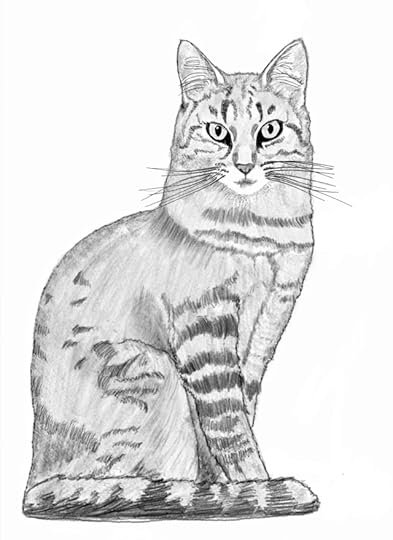 Charlie deigns to pose
Charlie deigns to poseOn the occasion of just after his second birthday, and having become jealous of his brother getting a portrait last week, Charlie deigns to pose. When you see him on his own like this he looks like a big cat. He isn’t. He’s actually very small and slightly built. He just gives the impression of heft. When you see them together, it’s obvious that George is 30% bigger.
As you can see, some parts of this sketch are more, well, sketchy than others. I was having trouble with my iPad: every time I came close to finishing, the native photo app just dumped all the edits and I was back to square one. After the third time I lost patience and just roughed out everything from his chin down.
I’ve learnt a fair bit since last week’s attempt. I’ve found that if I begin in Abode Fresco (or Sketch as was), then continue in Apple’s native photo editing app, I get enough of what I need for my level of skill. Right now I don’t need the ten million zillion choices of Photoshop; it’s overwhelming. At the level of figuring out how to show the curve and flow of fur, and how to create shadow (I truly am a beginner at this) I really, really don’t need to figure out the difference between ink and scratchy ink, or wet edges and shape dynamics—I just want a fucking pencil, y’know? Anyway, I’m enjoying this sketching thing now that I’ve found a way to make it simple.
Now that the cats are done I’m turning my attention to some birds, trying to figure out how to make little pictures I can use as icons for the maps I want to make. Per requests on Twitter and Facebook I’m starting with a couple of stabby birds: a bittern (for both SPEAR and MENEWOOD) and a shrike. But I want to do a wren and robin (a British round, Robin Redbreast: I love little round birds that look like truffles you could just pop in your mouth). Then maybe an eagle owl or tawny owl, too. Perhaps a rook. If I can figure out how to make something look fluffy I’ll do an owlet. After that, back to mammals: hedgehog, otter, horse…
Expect more random sketches in the future.
May 15, 2021
Happy Çaturday!
Here, on the occasion of his second birthday, is a drawing I made of George.
 George is 2
George is 2Image description: Black and white digital drawing of a tabby cat on a table. He is sitting slightly crooked and leaning forward a little with his tail not quite curled around his toes.
Charlie thinks it’s embarrassing and wouldn’t pose. I’ll get his soon…
I started playing with the various drawing apps for iPad and Pencil in service of creating icons for the HILD and MENEWOOD maps I’m making. I found doodling about remarkably relaxing, and as an added bonus, it frees my writing back brain to work without distraction. Also, it’s just plain satisfying to make things.
Sometime in the next week or so I’ll write a proper Kitten Report but for now, enjoy George.



